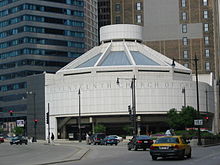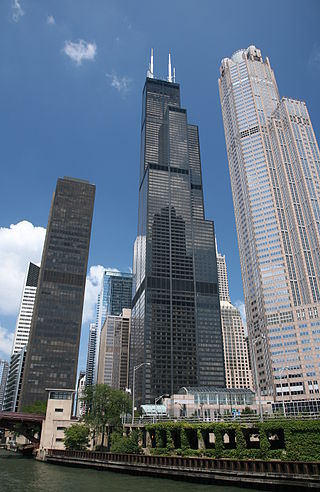
The buildings and architecture of Chicago reflect the city's history and multicultural heritage, featuring prominent buildings in a variety of styles. Most structures downtown were destroyed by the Great Chicago Fire in 1871.
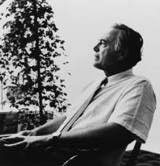
Harry Mohr Weese was an American architect who had an important role in 20th century modernism and historic preservation. His brother, Ben Weese, is also a renowned architect.
Henry John Schlacks was primarily known as an ecclesiologist in a 19th Century sense of the word, meaning one who designs and decorates churches. He was from Chicago, Illinois, and is considered by many to be the finest of Chicago's church architects. Schlacks trained at MIT and in the offices of Adler & Sullivan before starting his own practice. He founded the Architecture Department at the University of Notre Dame and designed several buildings in the Chicago area.
Benjamin Horace Weese was an American architect hailing from Chicago, and a member of the architects group, the Chicago Seven. Weese was the younger brother of Chicago architect Harry Weese.

Solon Spencer Beman was an American architect based in Chicago, Illinois and best known as the architect of the planned Pullman community and adjacent Pullman Company factory complex, as well as Chicago's renowned Fine Arts Building. Several of his other largest commissions, including the Pullman Office Building, Pabst Building, and Grand Central Station in Chicago, have since been demolished. Beman designed numerous Christian Science churches and influenced the design of countless more.

541 North Fairbanks Court, formerly the Time-Life Building, is a 404-foot-tall (123 m), 30-story skyscraper in Chicago, Illinois, designed by Harry Weese and completed in 1969. Located on the Near North Side, it was among the first in the U.S. to use double-deck elevators. The odd-numbered floors are accessible from the lower lobby, with even floors serviced from the upper level.
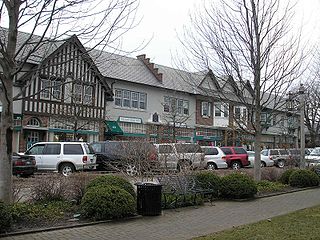
Howard Van Doren Shaw AIA was an architect in Chicago, Illinois. Shaw was a leader in the American Craftsman movement, best exemplified in his 1900 remodel of Second Presbyterian Church in Chicago. He designed Marktown, Clayton Mark's planned worker community in Northwest Indiana.
"America's Favorite Architecture" is a list of buildings and other structures identified as the most popular works of architecture in the United States.
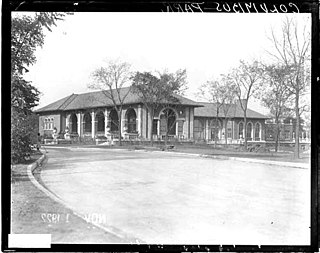
Columbus Park is a 135-acre (55 ha) park located on the far West Side of Chicago, Illinois, in the Austin neighborhood. It is considered the finest work by landscape architect Jens Jensen and was consequently named a National Historic Landmark in 2003.

UrbanLab is an American architecture and urban design firm with headquarters in Chicago. Founded by Martin Felsen, FAIA, and Sarah Dunn in 2001, the office is known for its focus on sustainability, creative experimentation and a collaborative approach to buildings, spaces and cities.

The MIT School of Architecture and Planning is one of the five schools of the Massachusetts Institute of Technology in Cambridge, Massachusetts. Founded in 1865 by William Robert Ware, the school offered the first architecture curriculum in the United States and was the first architecture program established within a university. MIT's Department of Architecture has consistently ranked among the top architecture/built environment schools in the world.
Charles Draper Faulkner was a Chicago-based American architect renowned for the churches and other buildings that he designed in the United States and Japan. He designed over 33 Christian Science church buildings and wrote a book called Christian Science Church Edifices.
Ralph Oscar Yeager, AIA, was an American architect who worked in Indiana. He was a partner in the Terre Haute, Indiana, architectural firm of Miller & Yeager and the Indianapolis, Indiana, architectural firm of Vonnegut, Wright & Yeager.
Archimania is a collective of architects and designers in the South Main Historic Arts District of downtown Memphis, Tennessee. The collective was founded in 1995 and is led by Todd Walker, FAIA, and Barry Alan Yoakum, FAIA.
Nagle Hartray Architecture is a Chicago architecture firm, founded in 1966. The company's early reputation was grounded in single-family and multi-family housing. Recent and current projects reflect diversification of the former focus, emphasizing educational, spiritual, civic, and media communication programs. Nagle Hartray has received over 75 industry design awards to date. In 2017, the firm merged with Sheehan Partners to form Sheehan Nagle Hartray Architects.
John Ronan is an American architect, designer and educator based in Chicago, in the United States. John Ronan FAIA is founding principal of John Ronan Architects in Chicago, founded in 1999.

The Charles N. Ramsey and Harry E. Weese House is a historic residence in Kenilworth, Illinois. Considered an excellent local example of an American Foursquare design, it is also the childhood home of architect Harry M. Weese.

Martin Felsen is an American architect and Fellow of the American Institute of Architects (FAIA). He directs UrbanLab, a Chicago-based architecture and urban design firm. Felsen's projects range in scale from houses such as the Hennepin, Illinois Residence, mixed-use residential and commercial buildings such as Upton's Naturals Headquarters, public open spaces such as the Smart Museum of Art Courtyard at the University of Chicago, and large scale, urban design projects such as Growing Water in Chicago and a masterplan for the Yangming Lake region of Changde, China. Felsen was awarded the 2009 Latrobe Prize by the American Institute of Architects, College of Fellows.
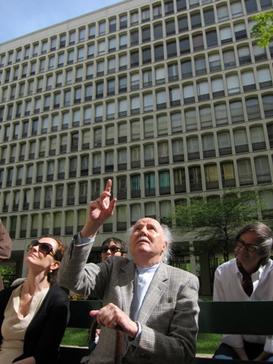
Araldo Cossutta was an architect who worked primarily in the United States. He worked at the firm I. M. Pei & Partners from 1956 to 1973. I. M. Pei has been among the most honored architects in the world. Cossutta was Pei's associate and ultimately his partner in the first phase of Pei's career. He was responsible for some of the firm's best-known designs from that era, including three that have received "landmark" designations in recent years. In 1973 he and Vincent Ponte left Pei's firm to form Cossutta & Ponte, which ultimately became Cossutta and Associates. The new firm designed the Credit Lyonnais Tower in Lyon, France (1977) and the Tower at Cityplace (1988) in Dallas, Texas, among other commissions.
The 227 East Walton Place Apartment Building is a historic apartment building located in the Near North Side community area of Chicago, Illinois in the United States.
